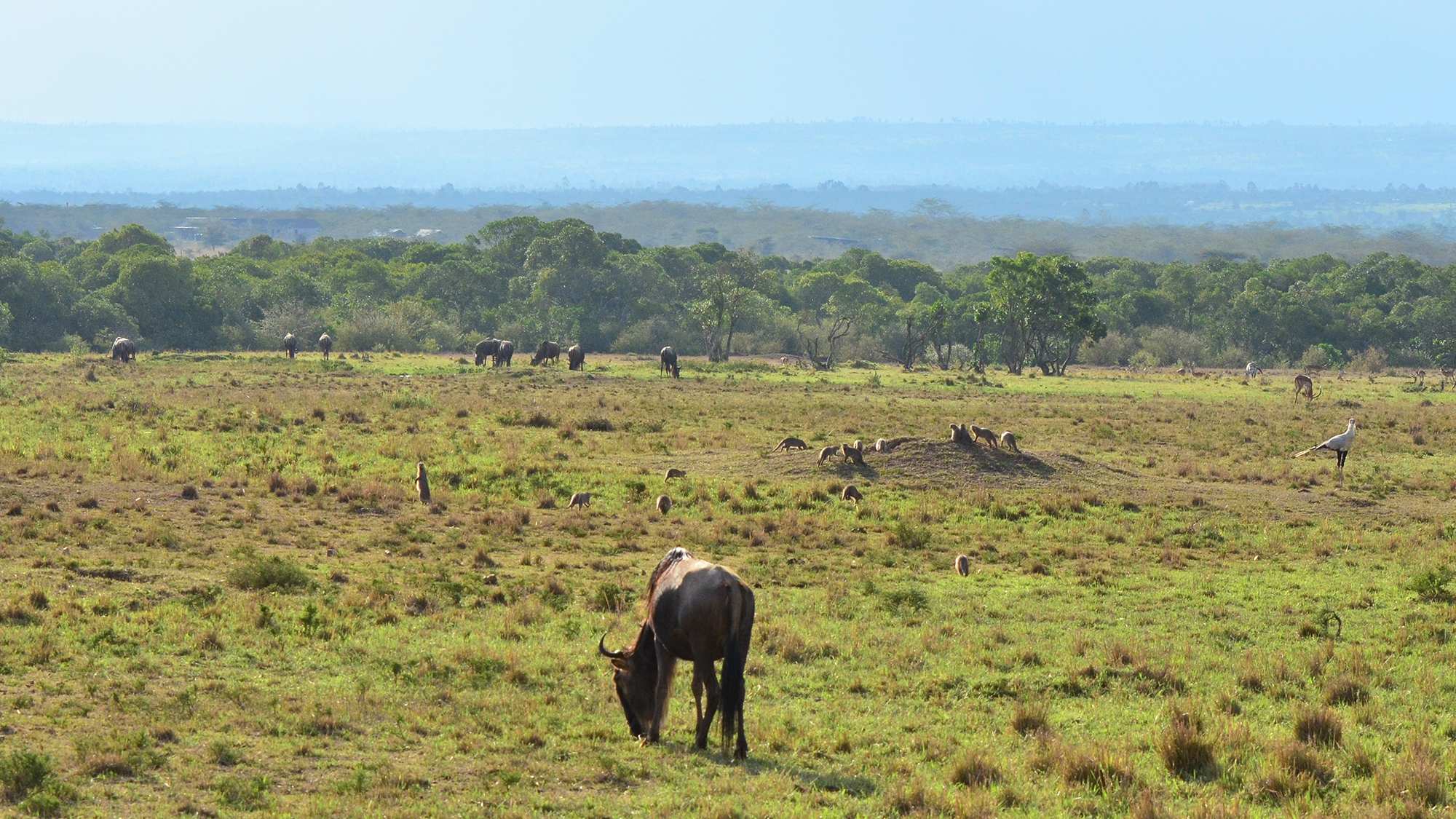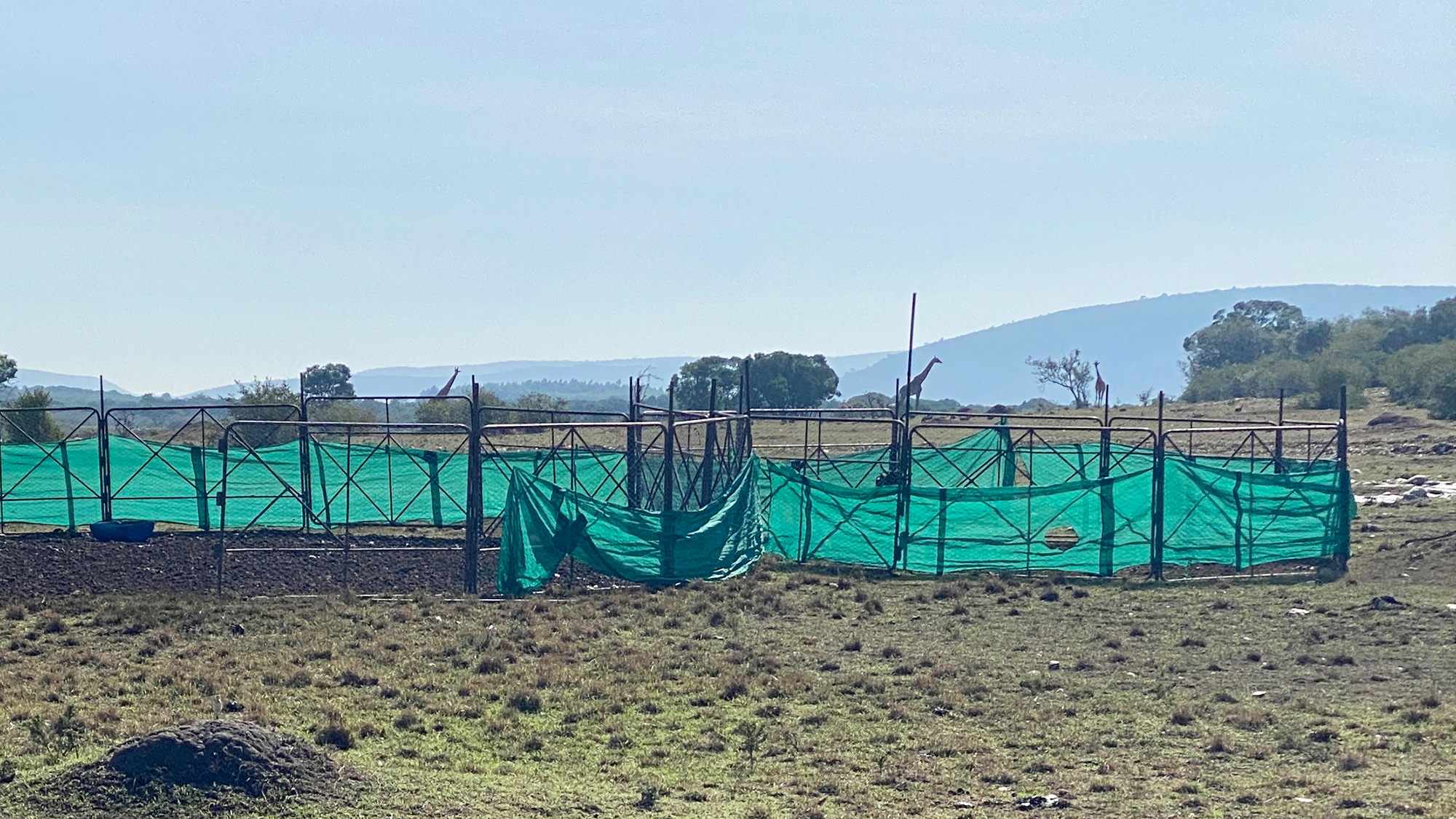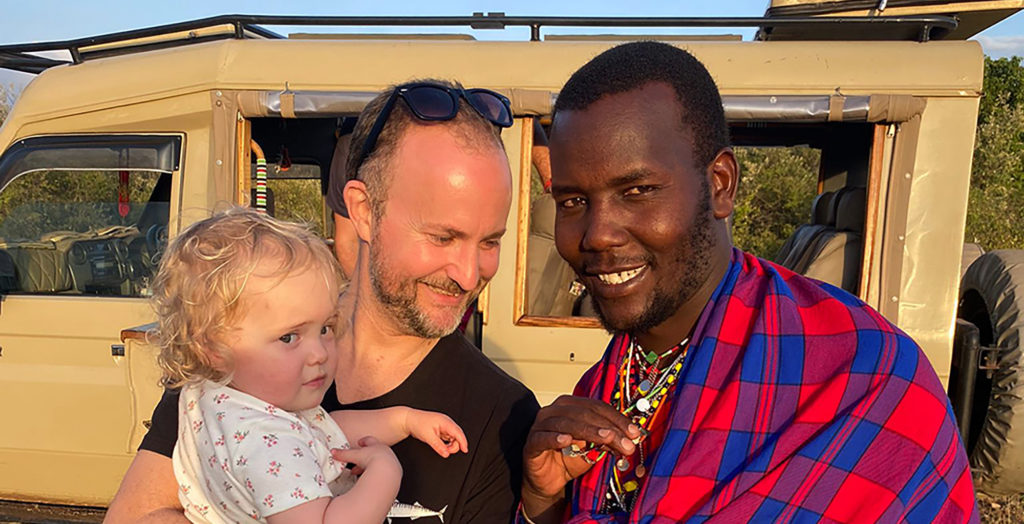Wildlife artivist Martin Aveling shares some highlights from his recent visit to Enonkishu, a wonderfully effective Maasai-owned conservancy situated in the Mara ecosystem. This trip formed part of the launch of the first project by Wild Art Philanthropy IRL or WAPI, a venture founded by Martin in partnership with Wild Philanthropy.
Dawn has just broken on the Enonkishu Conservancy in the greater Maasai Mara. A ring-necked dove leads a familiar morning chorus as light infiltrates the landscape and we head out on a game drive with Justus Lekishon, a freelance wildlife guide working with Journeys By Design and House in the Wild. Justus is studying to become the second Maasai person to achieve Gold-certified guide status, and only the 37th person in Kenya. Dressed head-to-toe in traditional clothing, Justus helps us into the car and we wrestle our 15-month-old away from his colourful beaded belt. The calming sound of nature is briefly interrupted by toddler tears, but they quickly fade thanks to a visual feast of moving forest green served up by our windowless reversing 4×4.

As we drive onto the conservancy we watch wildebeest grazing peacefully, dotted like paint spots across the grassland, enjoying the safety of daylight and the herd. We turn a corner and two small animals dive for cover into the bushes. They are dik-diks, a dainty, tan-coloured antelope with unusually large eyes, as though designed by imagineers at Disney. Justus explains that dik-diks rely on good vision to avoid stealth attacks from leopards and other predators who patrol the woodlands. He adds that lions will rarely attempt to tackle an agile dik-dik, as it requires the same amount of energy to take down a wildebeest, a far greater reward.
We drive on and Justus tells us of the origins of the word ‘mara’, saying that it means ‘spotted lands’, relating to a vast savannah landscape peppered with small trees when viewed from on top of a hill. He cracks a wry smile as he goes on to explain that only 10 years ago the very soil we are on was a working bean farm. Nature has clawed its way back to prominence and the landscape is slowly re-adopting the aesthetic of those familiar spotted lands.
In the distance, a lone hyena cuts a determined pace on the way back to its den after a night of scavenging. The tufted ears of bat-eared foxes flicker at the entrances to burrows, and warthogs, topis and zebras all convene for a session of grazing in the sun. We watch a business of banded mongooses chase a secretary bird, its quiver-like head and tail feathers bouncing as it scarpers. Justus tells us that the Masai know it as ‘olembae’ or ‘arrow bird’ from its archer-like appearance, and we all agree that this feels decidedly more appropriate than the antiquated comparison to clerks with quill pens from colonial times, to which the bird owes its common name. My wife, Amy, mentions that she studies dwarf mongooses and for a few minutes, Justus becomes the student, quizzing her on all aspects of dwarf mongoose social behaviour. Joking that he hopes they come up in his Gold guide test, Justus eases the Land Cruiser into gear and we move on.

The sun rises higher in the sky as we make our way across a vast landscape, previously degraded and now teeming with wildlife. In the heat of the day, we relax into this wilderness, feeling at one with the natural terrain, and then all of a sudden a herd of cattle comes into view. This feels like a surprising encounter to have on a game drive, but for Justus, it is entirely normal. He points to an enclosure a little further up to show us where the cattle slept last night. The bomas (enclosures) are moved every day, following a carefully managed grazing pattern. The cows graze right to the base of the shoots, encouraging new grass to grow, and the patches are not overused, which reduces competition with wild grazers.
Many of the local landowners with adjoining plots have opted to lease their land to the conservancy and allow wildlife back onto it. The landowners, many of them Maasai, are able to continue their traditional pastoral lifestyle, whilst also benefiting from the proceeds of ecotourism. The model has been so successful, particularly during recent years of drought, that other conservancies in the area are now adopting a similar strategy, further opening up the land and creating migration corridors for wildlife.
Justus spots a hooded vulture circling in the distance and we follow to see what it has found. We arrive at the scene of an impala kill. A stocky bateleur eagle is already picking away at the depleted carcass, and the vulture wades in for a share of the spoils. As we watch the birds go about their business, Justus regales us with stories from his grandparents, whose ancestors apparently used to leave the house with cooking pots on their heads in order to avoid aerial attacks from big birds of prey. As we clutch our daughter a little tighter, he reassures us that the animals were bigger, bolder, and more abundant back then before the balance of power tipped towards humans. The two birds eventually move on and Justus carefully inspects the remains. He surmises that it was likely a cat who took down the impala, based on strangling marks around its neck. He thinks it was a cheetah, although broken bones suggest that hyenas may also have paid a visit.
We drive around the area for a while to see if we can spot the culprit, but to no avail. At this point, hungry tummies are rumbling, and I’m reaching for the iPad loaded with emergency episodes of Peppa Pig. We decide that this would be a good time to return to base for lunch, and we all agree to come back to this same spot in the early evening. Speaking with Justus over lunch we learn that he is also a governor at a local school. He is passionate about educating the next generation on the value of conserving wildlife, and during his free time, he often takes local students out on game drives. Many children in the area only know wildlife as a pest. As the landscape became increasingly fragmented over the years, their experiences of wildlife were often that of conflict. Community leaders like Justus and others are helping to change the narrative, and the conservancy model is adding weight to their case for a holistic community-based approach to conservation.
Lippa and Tarquin Wood, who own House in the Wild, converted an old farm homestead into a boutique eco-lodge in 2011 and immediately set about launching a rewilding project. Their relationship with Justus goes back even further to when Justus received a new bike upon graduating from primary school, something Tarquin had promised to the highest-performing student that year. The fact that they are still close friends today points to the strong relationships that Lippa and Tarquin have built with local communities over many years, which is helping to make their ambitious project of rewilding the greater Maasai Mara a lasting success.

It is now late in the afternoon and we return to the spot where the impala was killed. Only the head remains. A sad sight, but we take comfort in knowing that nothing was wasted and many other animals benefited. We drive around the area for a while and sure enough, Justus spots a cheetah. Even through the binoculars, I’m struggling to see it, but as we approach, like a magic eye trick, a handsome male cheetah emerges into view, his spotted yellow coat in perfect harmony with the dry bleached blond grass in which he stretches out contentedly. Justus points to his belly and we all give a knowing nod. Bulging with impala meat, this cheetah is not going anywhere in a hurry.
Like so much wildlife across the world, cheetahs are vulnerable to extinction, with fewer than 7,000 remaining in the wild. For the time being though, this cheetah has all the space and food he needs to thrive, and it is thanks to meaningful collaborations between people. We sit with him for a while, admiring his beauty and contemplating how lucky our daughter is to see a cheetah in the wild before seeing one in a zoo. Musing on whether the same will be possible for her children in time, sitting there in the increasingly spotted landscape of the Enonkishu Conservancy, we allow ourselves to hope.
If you would like to learn more about WAPI or about Wild Philanthropy in general, please do get in touch.
